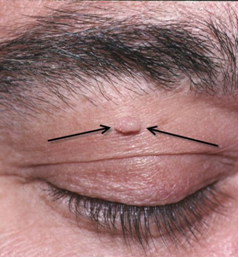Skin tags can occur in childhood but become more common as one ages. Additionally, they are subject to hormonal changes and pregnant women experience new skin tags. Skin tags are typically an aesthetic concern and do not cause any further problems. However, they may have a relationship to diabetes and obesity so you should have your blood sugar and weight checked by your primary care physician if you notice a sudden onset of many skin tags.
Fortunately, skin tags are simple to remove. Usually these are removed by a doctor using cryosurgery or cautery. Cryosurgery involves applying liquid nitrogen to the surface. This freezes the skin tag. Cautery uses high heat to burn off the skin tag. In both cases the skin tag falls off on its own. In some cases excision is required with the use of a scalpel or special scissors. Control of bleeding and infection is extremely important. Therefore, only a physician should remove skin tags; do not try to do this on your own at home.
Any suspicious bump on or near your eyelid should be examined by a physician. There are a number of warning signs that indicate that the bump may be a skin cancer. These include the “ABCDEs:”
on or near your eyelid should be examined by a physician. There are a number of warning signs that indicate that the bump may be a skin cancer. These include the “ABCDEs:”
A: Asymmetry
B: Borders are irregular
C: Color variation (more than one color)
D: Diameter (size is greater than a pencil eraser)
E: Evolution (anything new – growth, bleeding, itching)
These bumps can be excised by your physician and sent to a laboratory for examination. Remember, not all bumps are cancer. It may be a benign growth, infection or a sign of an underlying condition. Usually removal of the bump can be performed right in the office using a local anesthetic. Other cases require the equipment and safety of an operating room. After the bump is removed, you will likely be asked to apply an antibiotic ointment to prevent infection.


